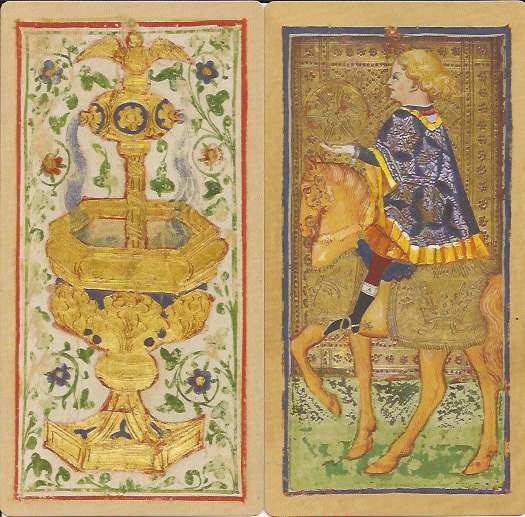A Brief History and Introduction to Tarot: from parlour game to powerful guidance tool
Today, we’re about to embark on a captivating exploration of tarot—its rich history from a renaissance parlour game to modern day powerful personal growth tool.
Let’s set the stage by traveling back to 15th-century Italy. Can you imagine? Tarot cards initially emerged as a form of playing cards, enjoyed primarily by the nobility for their entertainment value. One of the earliest known decks from this time is the Visconti-Sforza deck, beautifully illustrated but not initially connected to any mystical or spiritual practices. These cards were simply a way to unwind and have fun!

Image from www.tarot-heritage.com
As we move into the late 15th century, we start to see the tarot deck take shape into what we recognise today. A full tarot deck consists of 78 cards, divided into two main sections: the Major Arcana—with 22 trump cards—and the Minor Arcana, which has 56 suited cards. The Major Arcana features cards that represent significant life themes and experiences, like The Fool, The Lovers, and The Wheel of Fortune. These cards embody universal archetypes that resonate with our human journey, almost akin to the journey of the soul in Western astrology. Meanwhile, the Minor Arcana showcases everyday situations and challenges through four suits: Cups, Pentacles, Swords, and Wands, each representing different aspects of life.
Now, let’s fast forward to the 18th century, where tarot experienced a transformative shift thanks to influential thinkers like Antoine Court de Gébelin and Jean-Baptiste Alliette, also known as Etteilla. Court de Gébelin published “Le Monde Primitif,” suggesting that tarot cards contained ancient Egyptian wisdom, which piqued interest in tarot as a mystical system. Following in his footsteps, Etteilla was the first to create decks specifically designed for divination, emphasising the cards’ connections to esoteric knowledge. Their work helped solidify tarot’s reputation as a tool for gaining spiritual insight and wisdom.

Then came the 20th century, a pivotal time for tarot’s popularity! In 1909, the Rider-Waite-Smith deck was introduced, created by artist Pamela Colman Smith and occultist A.E. Waite. This deck was revolutionary, featuring richly illustrated imagery that made tarot accessible to the masses. It encouraged people to connect deeply with the cards on a personal level. Personally, I love using the Rider-Waite deck when teaching. While I may not personally resonate with it, its accessibility is unmatched, and there’s a plethora of literature available to aid newcomers in their learning journey.

Image from www.openculture.com
As interest in tarot grew, we began to see a delightful diversity of decks emerge, each with unique themes and artistic styles. Take the Thoth Tarot, for example, developed by Aleister Crowley, blending astrology, Kabbalah, and many other esoteric traditions into intricate symbolism. Or consider the Celtic Tarot, which draws imagery from rich Irish mythology. Isn’t it fascinating how creators are experimenting with imagery to promote inclusivity and representation? This variety truly allows individuals from all walks of life to find a deck that resonates deeply with their personal experiences.
Moreover, tarot has gracefully adapted across cultures, maintaining its relevance across various belief systems. In Japan, tarot may be blended with local spiritual practices, while Indigenous cultures might incorporate tarot into traditional storytelling. This global embrace speaks to the universal nature of tarot, making it a versatile tool for reflection, guidance, and personal growth.
If you’re just stepping into the world of tarot, it’s vital to select a deck that resonates with you. In a future episode, we’ll delve deeper into how to choose the right deck for your journey.
At Love Tarot Lounge, we’re all about unraveling tarot in a contextual way. Many of us turn to divination during significant life challenges, seeking clarity and insight about love, career, finances, and personal growth. We aim to connect tarot to these real-life questions so that you can navigate your journey more effectively.
Then came the 20th century, a pivotal time for tarot’s popularity! In 1909, the Rider-Waite-Smith deck was introduced, created by artist Pamela Colman Smith and occultist A.E. Waite. This deck was revolutionary, featuring richly illustrated imagery that made tarot accessible to the masses. It encouraged people to connect deeply with the cards on a personal level. Personally, I love using the Rider-Waite deck when teaching. While I may not personally resonate with it, its accessibility is unmatched, and there’s a plethora of literature available to aid newcomers in their learning journey.

Today, tarot is not only about divination; it’s embraced as a powerful personal growth tool. Each card drawn can spark reflection and insight, helping you assess your strengths and weaknesses. For example, drawing The Hermit might inspire you to seek solitude and introspection, while The Lovers may indicate significant choices ahead.
If you want to start using tarot for personal growth, here’s a tip: Begin by selecting a deck that resonates with you, take time to familiarise yourself with the cards, and consider journaling your thoughts as you read. A simple three-card spread can beautifully guide you through exploring your past, present, and future.
To wrap up, we’ve seen how tarot has evolved from a card game into a multifaceted tool for self-reflection and personal development. Future posts will dive into card meanings and other divination practices.



Sorry, the comment form is closed at this time.